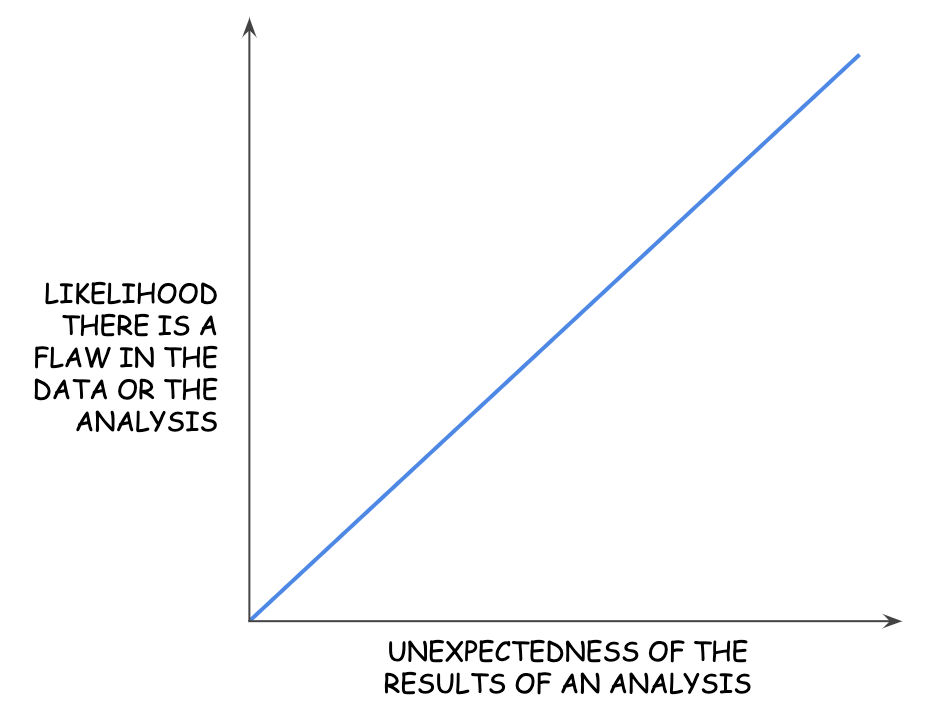It wasn’t all that long ago that successful digital analysts (which we called a “web analyst” at the time) were people who fell into the role because they simply happened to have an eclectic mix of personal traits:
- They were fascinated by the internet: not just the explosion of content that it was providing, but the underlying mechanics of how it actually worked.
- They were intrigued with the data that could be captured as visitors moved about their website, and how that data could then be explored.
- They loved using spreadsheets (Excel, at the time—Google Sheets was not yet a thing).
- They enjoyed being able to bring a unique perspective—a data-based perspective—to conversations about their organizations’ websites.
- They were innately curious: they simply could not stop themselves from having, “I wonder if…?” thoughts, and then were unable to rest until they had figured out how to answer those questions.
- They were “bilingual,” in that they spoke both the language of business and marketing, as well as the language of JavaScript and HTML; and, as such, they could translate business questions into technical data collection requirements.
Even back then, these were difficult people to find, as the most successful analysts had simply meandered through a series of roles in organizations until they stumbled into the world of digital analytics and suddenly felt at home.
Over time, the industry has matured, and the people who stumbled into these roles started to find each other and develop a sense of community. The Digital Analytics Association was created as an industry association, the Measure Slack team was created as a free forum for digital analysts to interact directly with each other, Web Analytics Wednesdays were created as local networking and educational meetups around the world (including in Columbus), and MeasureCamp unconferences began to spring up around the world.
Through those communities and the discussions that are now occurring in them, it is clear that the role of the digital analyst is rapidly and dynamically changing.
The World of Digital Analytics Has Gotten More Complicated
There are two driving factors that have made the world of digital analytics increasingly complex.
First, we have moved well beyond “the website” as the primary domain of the digital analyst. Mobile devices and social media added additional data that naturally fell to the digital analyst to incorporate into their work, and, today, there are no customer experiences that are not either directly occurring digitally or that do not quickly get translated into digital data: call center interactions have key information captured in the call center software, while calls are often recorded and can then be transcribed automatically using machine learning; CRM systems track each interaction, be it through email, phone call, or in-person, that the sales team has with each lead; inventory management and ERP systems digitally track what products are available and to whom; the list goes on. Analysts can no longer operate with a couple of silos of data that they occasionally join together.
Second, the collection of customer data has gotten increasingly complicated:
- For websites and mobile apps, tag management systems now operate as an additional—but critical—layer in the process.
- Emerging privacy regulations (see GDPR, CCPA) have introduced requirements around what consumer data can be collected, where it can be stored and processed, and how it can be used.
- All major browsers and operating systems are introducing increasingly tighter restrictions around what can be tracked and how within their platforms—aggressively expiring cookies, locking down what app information is available for analytics, and so on.
So, while there is an increasing amount of digital activity by consumers, the actual appropriate, ethical, and technically feasible collection and integration of that data is growing in complexity.
What Makes for an Effective Digital Analyst in Today’s World?
A few things haven’t changed from “way back when” to “now” when it comes to some of the innate attributes of an effective analyst:
- Motivated Curiosity—the effective analyst needs to take in each new piece of data she gets and consider it from multiple directions: thinking about the ramifications of the data and whether it reinforces, contradicts, or does neither when it comes to the organization’s current beliefs and hypotheses.
- Skepticism—an organization’s data is increasingly complex and, if the initial analysis of the data yields an incredibly surprising result, there is a very good chance there is a flaw in the data or the analysis. An analyst’s skepticism will drive her to come at the result from multiple directions rather than accepting the initial result at face value.

- “Bilingual” Fluency—the analyst’s ability to understand the technical details of data collection (think tag management systems, cookies, digital analytics and media conversion tags) and the ins and outs of marketing strategies and tactics, remains critically important. Since both of these areas are growing increasingly complex, the analyst has to be wired to always be learning.
- Effective Communication—while no job description has been written in any field in the past 50 years that does not list “effective communication” as a requirement of the successful candidate, this truly is an imperative for the analyst: she needs to not only be fluent in both the technical and the business aspects of her world, but she needs to be able to translate between those worlds and she needs to be able to effectively communicate the results of any analysis she conducts so that it is clearly understood by her stakeholders.
While training can refine and enhance these capabilities, all of these characteristics really need to be innately baked into who the analyst is.
At the same time, there are additional capabilities that are increasingly necessary for the analyst:
- Moving Beyond Spreadsheets—while Excel and Google Spreadsheets are not going away, analysts increasingly need to be able to combine multiple data sets; build dashboards and reports that are dynamically and automatically updated, as well as that include interactivity to enable their stakeholders to perform some basic exploration of the data on their own; and work with raw (user-level, hit-level) data that exceeds the row limits of a spreadsheet. This means adding one or more BI platforms (Tableau, Power BI, Qlik, Domo, etc.) to their toolbelt, as well as, potentially, adding the ability to program with data using Python or R (the realm of machine learning and data science).
- Increasing Use of Statistics—historically, much of digital analytics was about looking for trends in aggregated metrics and, occasionally, checking for statistical significance in the results of an A/B test. As the data gets larger, richer, and more granular, analysts increasingly need to get to a deeper level to be able to perform regression analysis, cluster analysis, classification, and even to get into the domain of machine learning to build and evaluate more sophisticated predictive models. At the same time, this means getting at least a passing familiarity with confusion matrices, causal inference, and various processes for applying data science to business problems.
- Moving Beyond “The Digital Experience”—inherent in both of the above is that analysts increasingly need to work with data from multiple sources rather than working almost exclusively within the context of a digital analytics platform like Google Analytics or Adobe Analytics.
None of these are trivial avenues to explore, but 10 years from now, they will be core expectations of any analyst.
These Are Exciting Times in Analytics
So, what does all of this mean for the analyst and for the organizations looking to hire and grow their analysts?
For the analyst, it means she must have a plan to continuously grow her skills beyond what is being asked of her in her current role. All of the communities—both the in-person ones and the digital ones—described at the beginning of this post are excellent resources for finding out how other analysts are working to continuously hone their skills. There are countless MOOCs, podcasts, webinars, and even books abound that support virtually any style of learning. And, data is plentiful that can be used to practice applying those knew skills, be it data available within the organization where she works or data available through Google’s Dataset Search, Kaggle datasets, data.world, or elsewhere.
For the organization, this shifting landscape means that great analysts are increasingly difficult to find, attract, and retain through a traditional “post a job, evaluate the resumes” process. Talented analysts have had the upper hand on the supply vs. demand front for a while, and that will continue, so organizations need to have a robust strategy for keeping those positions filled. The strategy should include getting involved with local (and national) digital analytics organizations and events, including getting existing team members (analysts and/or their stakeholders) engaging in those organizations. This will both build a talent network and help them understand the realities of the space. And, for analysts who are already working at the organization, they should be allowed and encouraged to grow their skills—through attending conferences, pursuing training, and being given some space to put the new skills they’re developing to use within the organization itself, even if that work yields only modest results initially.
These are exciting times for analytics. But, with excitement comes a bit of fear, a lot of uncertainty, and the occasional misstep. Organizations and analysts alike need to recognize (and embrace!) this reality.

Written By
Tim Wilson
Tim Wilson is a Senior Analytics Director at, Search Discovery a data transformation company. He has been working with digital data full-time since 2001 in a variety of roles: from managing a web analytics platform migration and developing analytics processes as the head of the business intelligence department at a $500 million high tech B2B company; to creating and growing the analytics practices at three different agencies that worked with a range of large consumer brands; to consulting with the digital analytics teams at Fortune 500 companies on their strategies, processes, and tactics for effectively putting their digital data to actionable use. Tim is a long-time creator and curator of pragmatic content for analysts and marketers, including co-organizing the monthly Columbus Web Analytics Wednesday meetup, co-hosting the bi-weekly Digital Analytics Power Hour podcast (analyticshour.io) and co-creating dartistics.com —a site dedicated to encouraging analysts to learn the R programming language and apply statistical methods to their data.
Tim is physically based in Columbus, Ohio, while his heart and soul maintain joint custody with Austin, Texas.
